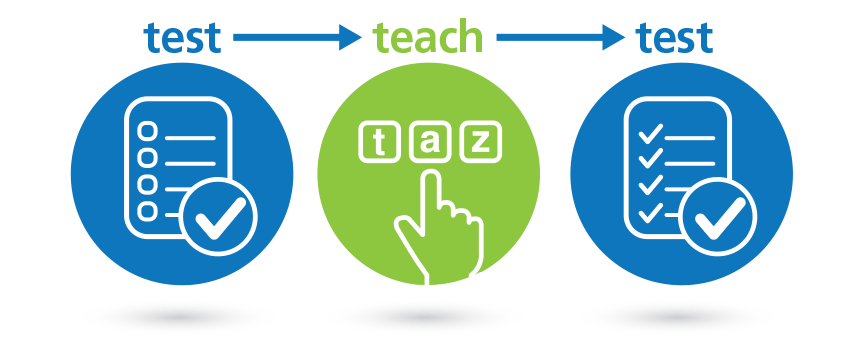The CUBED assesses decoding and foundational code skills using the Dynamic Decoding Measures (DDM), which is comprised of three dynamic assessments with multiple levels (targets). DDM uses a ‘testing the limits’, or ‘test-teach-retest’ dynamic assessment process, to identify a student’s current level of performance. This highlights learning potential for phonemic awareness, identification of words, letters, and sounds, and nonsense word decoding.

- The DDM is administered and scored in real-time.
- The DDM does not have specific grade levels for benchmark screening or progress monitoring.
- Students in preschool can be administered the same DDM measures as students in third grade (or higher). This is possible because of the range of target skills assessed within each of the DDM measures.
The Role of Decoding in Primary School Reading Assessment
Two constructs are measured with the CUBED: decoding and language. The conflation of those two separate constructs is often referred to as reading. The authors used this “simple view of reading” (Gough and Tunmer, 1986) as a general guide in the construction of the CUBED. They also used Alan Kamhi’s (2007, 2009) “narrow view of reading” as a frame of reference, which reminded us of the importance of maintaining separation when measuring these two constructs. According to the narrow view of reading, reading is defined as word recognition or decoding. Comprehension is removed from the reading construct because it already pertains to a clearly defined construct – language.
To measure the construct of decoding, the authors identified four core behaviors to measure based on Common Core State Standards and a thorough review of the research. They further analyzed those behaviors for underlying skills and processes that would help identify a student’s zone of proximal development. Those four decoding behaviors are phonemic awareness (with phoneme segmentation, first sound identification, and phoneme blending targets), word identification (with irregular word reading, letter-sound identification, and letter-name identification targets), decoding (with CVC, CCVC, and silent ‘e’ nonsense words targets), and decoding fluency (obtained from reading a narrative passage).
Pinpoint Exactly Where Students Struggle with Decoding in Minutes!


DDM Phonemic Awareness Measure: Phonemic awareness is foundational to the decoding process. It is the ability to identify and manipulate individual sounds (phonemes) in words. When decoding written words (vocally or sub-vocally), a student converts arbitrary symbols to sounds (graphemes to phonemes). The student can then recognize those sounds as words in oral language. If a student cannot recognize the different phonemes in a word, then that student will likely not be able to assign different phonemes to different letters to decode. Although measuring phonemic awareness is not the same thing as measuring decoding, it is highly predictive of decoding ability. Quality instruction in phonemic awareness can lead to an improvement in decoding. Once a student can successfully segment words into phonemes orally, he or she likely has sufficient phonemic awareness to decode written words.
DDM Word Identification Measure: Word identification is the rapid, automatized recognition of written words. The process requires the ability to automatically map a sound (or a group of sounds) onto a symbol (or group of symbols) from memory. A fluent, effective reader’s word identification skills are typically exceptionally high as they almost exclusively use a word identification process when reading. The DDM Word Identification has three targets. Target 1 of the DDM Word Identification is Irregular Words, Target 2 is Letter Sounds, and Target 3 is Letter Names. It also uses a ‘testing the limits’ dynamic assessment procedure to identify the student’s instructional level and to measure the extent to which that student is progressing in his or her automatic recall of different words, sounds, or letters.
DDM Decoding Measure: Decoding allows for the actual measurement of the decoding construct, even before a student can decode. It uses a dynamic assessment of the ‘test-teach-retest’ format to identify the student’s current instructional level. It also measures a student’s modifiability in learning to decode. Modifiability refers to the extent to which a student is able to learn something new. The DDM Decoding uses nonsense words to ensure students cannot rely on prior knowledge of real words to decode. Nonsense words also allow for an unbiased pretest, where most young students are likely unfamiliar with the nonsense words at pretest, setting the stage for teaching to take place.
